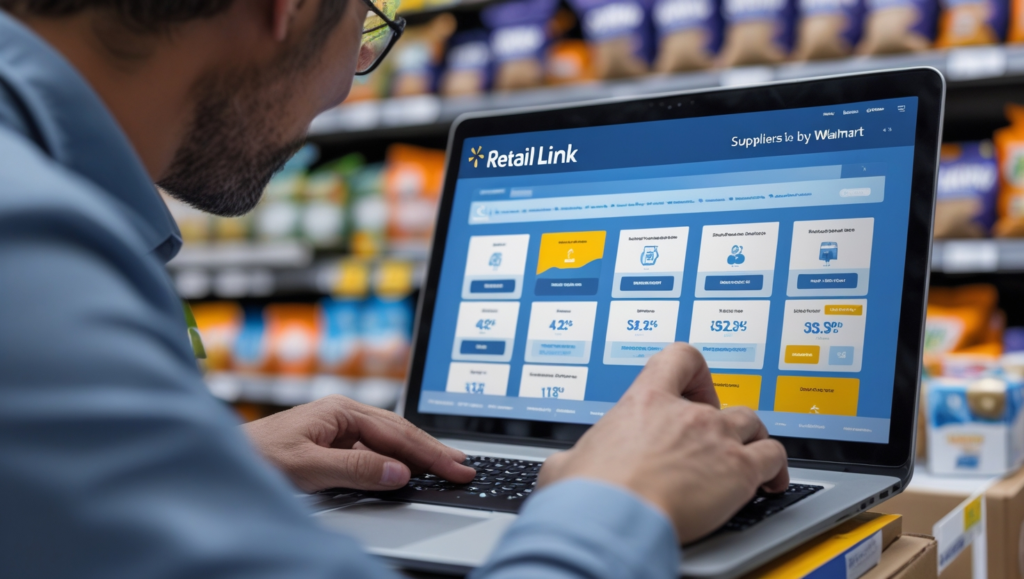Retail Link is a special tool that Walmart gives to its suppliers. It helps them see important information about their products. For example, suppliers can check how much they’ve sold, how many items are left in stock, and even predict what customers might buy next. Retail Link is a comprehensive dashboard that enables suppliers to access all the necessary data to make informed decisions. It’s important because it allows suppliers to work more effectively with Walmart. In this article, we’ll explain what Retail Link is, how it works, and why it’s so helpful. Let’s start by learning what Retail Link does for suppliers.
What Is Retail Link?
Retail Link is Walmart’s online platform for suppliers. It’s a place where suppliers can log in and see lots of information about their products. For instance, they can examine sales data to determine how many items were sold in a week. They can also check inventory management to know how much stock is left in Walmart’s warehouses. Additionally, Retail Link offers tools for forecasting, which enable estimating future product demand. It helps suppliers plan. So, Retail Link is like a helper that gives suppliers the information they need to succeed with Walmart.
The Story of Retail Link
Retail Link was established many years ago as a straightforward method for Walmart to exchange data with its suppliers. Initially, it was primarily about displaying sales numbers. However, over time, it evolved into a comprehensive system with numerous features. Now, Retail Link includes tools such as supply chain management, analytics, and even weather data to help suppliers understand how weather affects their sales. Walmart continually updates Retail Link to improve it. For example, they added real-time updates so suppliers can view the latest information immediately. Today, Retail Link is a must-have for any Walmart supplier who wants to do well.
Key Features of Retail Link
Retail Link has many helpful features. Let’s look at some of the main ones. First, it offers reporting software that enables suppliers to create reports about their products. Next, the point of sale shows what customers buy at checkout. Then, inventory management helps suppliers track stock levels.
Additionally, purchase orders enable suppliers to see what Walmart needs and when. Finally, scorecards grade suppliers on their performance, like OTIF compliance. Each feature makes it easier for suppliers to work with Walmart. Consequently, Retail Link helps suppliers keep customers happy by providing all these tools in one place.
How Retail Link Helps with Sales Data
Sales data is super essential in Retail Link. It informs suppliers of the number of products they’ve sold. For example, a supplier can see if a toy sold more in one store than another. It helps them decide where to send more toys. Additionally, sales data reveals patterns, such as whether a product sells better on weekends. With this information, suppliers can plan better. Retail Link makes it easy to find this data. Suppliers can even download reports to share with their teams. Therefore, Retail Link is an excellent tool for understanding customer needs and driving sales.

Managing Inventory with Retail Link
Inventory management is a big part of Retail Link. It helps suppliers know how much product is in Walmart’s warehouses and stores. For instance, if a supplier sees a warehouse is low on cereal, they can send more boxes. Retail Link also shows how fast products are selling. It helps suppliers determine the optimal quantity to produce. As a result, Walmart always has enough stock for customers. Moreover, Retail Link can alert suppliers if there’s a problem, like a late shipment. So, Retail Link keeps everything running smoothly and ensures products are always available.
Forecasting: Planning for the Future
Forecasting in Retail Link is like looking into the future. It helps suppliers guess how much product Walmart will need. For example, if Retail Link shows that people buy more ice cream in the summer, suppliers can make extra stock before summer starts. Retail Link uses past sales data and even weather data to make these guesses. This way, suppliers can prepare for periods of high demand. Additionally, forecasting helps suppliers avoid making too much or too little product. Because of this, Retail Link’s forecasting tools are invaluable for planning and keeping Walmart stock.
Understanding Scorecards in Retail Link
Scorecards in Retail Link serve as a form of evaluation for suppliers. They demonstrate the performance of suppliers in various areas. For example, there’s a scorecard for OTIF compliance, which means delivering orders on time and in full. If a supplier has a good score, it shows they’re doing great. However, if the score is low, they might need to improve. Retail Link makes it easy to view these scores and determine what to address. As a result, suppliers can use scorecards to get better. Thus, Retail Link helps suppliers maintain a good working relationship with Walmart.
Market Basket: What Customers Buy Together
The market basket is a cool feature in Retail Link. It shows what products customers buy together. For instance, if lots of people buy hot dogs and buns at the same time, Retail Link will notice that. It helps suppliers understand which products pair well together. Then, they can suggest Walmart put those items near each other in stores.
Additionally, suppliers can create special deals, like a discount on buns with hot dogs. Therefore, the market basket enables suppliers to sell more by learning about customer habits. Consequently, Retail Link makes it easier to boost sales this way.
Weather Data: How Weather Affects Sales
Weather data in Retail Link is exciting. It shows how the weather changes what people buy. For example, on hot days, people might buy more sunscreen or fans. On rainy days, they might grab umbrellas. Retail Link uses this information to help suppliers plan their operations. If a supplier knows a heatwave is coming, they can send more summer products to Walmart. It ensures Walmart has what customers need. Moreover, weather data also helps with forecasting. Therefore, Retail Link’s weather tools make suppliers smarter about their products and keep stores ready for any weather.

Purchase Orders: Keeping Track of Orders
Purchase orders are a key part of Retail Link. They show what Walmart has ordered from suppliers. For example, if Walmart needs 100 boxes of cereal, they’ll send a purchase order for that. Retail Link allows suppliers to view these orders and ensure they send the correct amount on time. Additionally, suppliers can check if Walmart got the order. If there’s a problem, like a late delivery, Retail Link will show that, too. So, purchase orders in Retail Link help suppliers stay organized. This way, they avoid mistakes and keep Walmart happy.
OTIF Compliance: Delivering on Time
OTIF stands for On-Time In-Full, and it’s a big deal in Retail Link. It means suppliers must deliver exactly what Walmart ordered, right on time. If a supplier is late or sends the wrong amount, their OTIF score drops. Retail Link has tools to help suppliers track their OTIF performance. For instance, they can see if they’ve missed any deliveries. Then, they can fix the problem before it happens again. Because of this, Retail Link is crucial for suppliers seeking high OTIF scores. It helps them deliver perfectly every time.
Supplier Portal: Your Home in Retail Link
The supplier portal is like the front door of Retail Link. It’s where suppliers log in to see all their information. Once inside, they can check sales data, inventory levels, and more. The portal is easy to use, with menus and buttons that lead to different tools. For example, there’s a section for analytics to dig deeper into data.
Additionally, the portal features help guides and videos to teach suppliers how to utilize all its features. So, the supplier portal makes Retail Link friendly and straightforward. Suppliers can get started quickly and easily.
Analytics: Digging Deeper into Data
Analytics in Retail Link is designed for suppliers who want to gain a deeper understanding of their data. It’s like a magnifying glass that shows small details. For instance, suppliers can examine sales by region or by time of day. It helps them find patterns, such as whether a product sells better in the morning. Additionally, analytics can show which stores need more products or which items aren’t selling well. With this information, suppliers can make informed choices, such as sending more stock to busy stores. Therefore, Retail Link’s analytics tools are powerful for driving sales growth and enhancing performance.
Deduction Management: Handling Money Matters
Deduction management is about money in Retail Link. Sometimes, Walmart deducts money from suppliers for issues such as late deliveries or damaged goods. These are called deductions. Retail Link provides tools to help suppliers identify and understand these deductions. For example, if a supplier sees a deduction for a late shipment, they can check their OTIF score.
Additionally, suppliers can dispute deductions if they think there’s a mistake. So, Retail Link helps suppliers keep track of their money. This way, they can fix issues and stay on top of finances.
APDP: A Special Tool for Deductions
APDP stands for Accounts Payable Disputes Portal in Retail Link. It’s a tool that allows suppliers to handle deductions. For instance, if a supplier disagrees with a deduction, they can use APDP to tell Walmart why. This tool makes it easier to fix money problems. Additionally, APDP displays the status of each dispute, allowing suppliers to determine if it has been resolved. Because of this, Retail Link’s APDP is super helpful for keeping finances in order. Suppliers can focus on selling instead of worrying about money mistakes. It’s an excellent feature for suppliers.
Real-Time Updates: Always Know What’s Happening
Real-time updates are an excellent feature in Retail Link. They mean the information suppliers see is always fresh. For example, if a customer purchases a product, the sales data is updated immediately. It helps suppliers make quick decisions. If they see a product selling fast, they can send more to Walmart immediately.
Additionally, real-time updates facilitate efficient inventory management, enabling suppliers to know exactly how much stock is available. Therefore, Retail Link keeps suppliers informed at all times. It’s perfect for staying ahead and keeping Walmart stocked.

Category Planning: Organizing Products
Category planning in Retail Link is about grouping products. For example, all the cereal might be in one category, and all the toys in another. It helps suppliers understand how their products fit into Walmart’s broader strategy. Additionally, category planning shows which categories are growing or shrinking. With this information, suppliers can determine whether to produce more products for a popular category. Moreover, Retail Link provides tools to help with category planning. As a result, suppliers can succeed by organizing their products well and meeting customer needs.
EDLP Strategy: Everyday Low Prices
EDLP stands for Everyday Low Prices, Walmart’s way of keeping prices low all the time. Retail Link helps suppliers understand how EDLP affects their products. For instance, suppliers can see if their prices are competitive. If a product is too expensive, it might not sell well. Additionally, Retail Link can help suppliers identify ways to lower costs without incurring losses. Because of this, suppliers can help Walmart keep prices low for customers. Therefore, Retail Link is crucial for making EDLP effective. It ensures suppliers and Walmart both win with low prices.
How to Use Retail Link: A Simple Guide
Using Retail Link is easy once you know how. First, suppliers log in to the supplier portal. Then, they can choose what to view, such as sales data or inventory levels. For example, to check sales, they click on the reporting software section. Next, they pick the dates they want to look at. After that, Retail Link shows a report with all the information.
Additionally, suppliers can save reports or share them with their teams. So, Retail Link is user-friendly and helpful. Even new suppliers can learn it fast and start using it.
Challenges with Retail Links and How to Fix Them
Sometimes, suppliers face challenges with Retail Link. For instance, they may struggle to comprehend all the data. However, Retail Link has help guides and videos to teach them. Another challenge is keeping up with real-time updates, but suppliers can set alerts to stay informed. Additionally, some struggle with OTIF compliance, but Retail Link’s scorecards help them improve. As a result, Retail Link offers solutions for common issues. Suppliers need to explore the tools and ask for help if needed. This way, they can easily overcome any challenge.
Conclusion: Start Using Retail Link Today!
Retail Link is a powerful tool for Walmart suppliers. It helps with sales data, inventory management, forecasting, and many more applications. With Retail Link, suppliers can make wise choices and grow their business. Plus, it’s easy to use, even for beginners. If you’re a Walmart supplier, start using Retail Link today. Log in to the supplier portal and explore all the features. You’ll see how it can make your work easier and help you sell more. Don’t wait—dive into Retail Link now and take your business to the next level! Success is just a click away.
References
- SupplierWiki. “Retail Link Essentials for Walmart Suppliers.” Retrieved from supplierwiki.supplypike.com
- SupplierWiki. “Top Metrics to Watch Monday Morning.” Retrieved from supplierwiki.supplypike.com
- SCMJDO. “Walmart Supply Chain: How to Build an Integrated Supply Chain.” Retrieved from scmjdo.com
- IntexSoft. “Ecommerce Inventory Management Software: Features, Types, Best Platforms 2024.” Retrieved from intexsoft.com
- Inymbus Blog. “Walmart Retail Link – Leveraging Apps and Automation.” Retrieved from blog.inymbus.com





